University of Minnesota 2014 Research Update
 On January 18th, the Minnesota Grape Growers Association and the University of Minnesota sponsored a Research Update at the Minnesota Landscape Arboretum in Chanhassen.
On January 18th, the Minnesota Grape Growers Association and the University of Minnesota sponsored a Research Update at the Minnesota Landscape Arboretum in Chanhassen.
As usual, all topics were perfectly presented and very informative. I would also like to mention that the wine tasting after the meeting was phenomenal. During the last decade, the quality of cool climate wines has improved dramatically and we now have Vinifera quality wines.
The Research Update was divided into five sections, which are outlined below.
Viticulture in China (Hebei region) presented by University of Minnesota scientist and grape breeder Peter Hemstad.
There are now 500 Marquette vines growing in the Hebei region of China, which is in the northeast part of the country. The most popular variety in China is Cabernet, of which there are thousands of acres under cultivation. The Chinese are training the Marquette vines on a G-type training system, similar to the way sensitive varieties are handled in Minnesota (see photo below.)
Most Chinese vineyards have concrete posts. But some growers are replacing them with wood posts imported from other countries, mainly for esthetic reasons. In the past five years, the Chinese have switched from manual vineyard labor to machines and specially designed vineyard tractors. (According to a recent report from Silicon Valley Bank, China is now the fifth largest grape producing country in the world.)
Viticultural Year 2013 In Review and 2014 Status Report presented by Peter Hemstad.
Every growing season presents challenges, but overall the wine grapes developed by the University of Minnesota are proving to be reliable producers. Statistically, primary bud survival for the last four years was very high for the main cultivars (Frontenac, Frontenac Gris and Marquette ) varying between 95.1% and 97.5% at the Horticultural Research Center. And for Swenson Red, the average bud survival was constant at about 55.2%, which is usual for our climate.
Statistics for bud survival during the 2013 growing season for Frontenac (including the Blanc and Gris clones), Baltica and Marquette was about 100%. For Cynthiana, bud survival was 88%, and for southern Riparia Gloire (which is usually used as a rootstock) only 77.1%.
During 2013, many varieties ripened about two weeks late because of a late start to the growing season. Last season was practically saved by above normal temps during September.
This winter, bud survival on January 17, 2014 is already less than 2013. Listed below are the bud survival rates observed at the Horticultural Research Center in Chanhassen.
Primary buds (Secondary buds)
-La Crescent: 57.5% (85%)
– Marquette: 47% (87.5%)
-Foch: 45% (82.5%)
-Frontenac: 45% (97.5%)
-St.Pepin: 45% (85%)
-St.Croix: 40% (87.5%)
A good amount of breeding is being done at the University with Cabernet. That’s because Cabernet is the most popular variety around the world and there is demand for a hardier version of it. Other current breeding projects include:
MN 1251 – Appears to be a much better vine than La Crescent.
MN1271, MN1311 (blue), MN 1313- New selections similar to La Crescent.
MN 1314 (blue) – Inter specific hybrid which includes a Seyval parent.
There is also an ongoing cold hardy rootstock project. Much of this work entails grafting Marquette on different rootstocks.
 The VitisGen Project: Enabling DNA Informed Grape Breeding by James Luby, Ph.D, University of Minnesota.
The VitisGen Project: Enabling DNA Informed Grape Breeding by James Luby, Ph.D, University of Minnesota.
The University of Minnesota is involved in this project which combines genomics technology and socioeconomic research to further grape breeding around the world.
VitisGen is identifying DNA markers in grape breeding. This has a number of beneficial applications. For example, genotyping can help identify or reject grape parents. It also provides a basis for selecting parents for crossing.
Genetic maps being developed by the VitisGen team can also be used to predict genetically based problems and diseases. VitisGen, which is under the direction of Dr. Bruce Reisch at Cornell, hopes to remove some of the guesswork that currently surrounds flowering time and berry size, shape and color.
VitisGen has a huge goal for 2015: Identify 2,632 markers per grape chromosome and about 50,000 markers total. For comparison, during 2010, only about 30 markers per chromosome and 570 total markers were identified.
The University of Minnesota is mainly involved in identifying markers for hardiness and diseases for the VitisGen project.
Enology Lab Update by University of Minnesota enology project leader Katie Cook.
During 2013, many micro-wine samples were evaluated with the goal of identifying the enological potential for cold hardy cultivars.
Many of the evaluations were for MN1314, a new, developmental grape that Peter Hemstad also mentioned during his presentation. These evaluations involve microvinification (2-10 litre wine samples) and a detailed analysis of grape chemistry including residual sugar, pH, SO2, titratable acidity and phenolics.
Another enological study at the University is looking at yeast selection, one of the most common questions surrounding cool climate winemaking. So much of yeast selection depends on juice chemistry, which is a relatively new area of study for hybrid grapes.
One interesting yeast evaluation study has been underway for two years. This study also has a sensory analysis component.
In the study, different variations of yeast were used for Frontenac (ICV GRe, Lalvin Rhone 4600, ICV Opale), Frontenac Gris (DV10, NT116, VIN 13), Marquette (ICV GRe, ICV D254, Levuline BR6) and La Crescent (Lalvin DV10, Vitilevure Elixir).
Despite differing individual consumer preferences for wines made with wine different yeasts, there was no significant overall taste preference resulting from yeast selection. (In other words, individual preferences did not result in a group consensus.) As a medical professional, I can explain these results very simply: Each consumer has his or her own personal sensory mechanism which reacts slightly differently to different flavors and aromas.
Katie also discussed a study that looks at the relationship between berry ripening and the sensory characteristics of Marquette. This study was conducted by Zata Vickers and graduate student Emily Del Bel, both of the University of Minnesota, as part of the Northern Grapes Project.
 When Marquette is around 26 degrees Brix, it tastes less sour, more sweet and has reduced fruit flavors. However, at 22-23 Brix, Marquette has more fresh fruit aromas, but is more acidic.
When Marquette is around 26 degrees Brix, it tastes less sour, more sweet and has reduced fruit flavors. However, at 22-23 Brix, Marquette has more fresh fruit aromas, but is more acidic.
The results for Frontenac were similar: Fresh fruit aromas tend to go down when Brix is going up. This is an important conclusion for making the right wine style decisions.
Another University research project is an evaluation of color and flavor compounds in Frontenac Gris.
In this research, multiple 2 mm cross berry sections are first gradually removed with a blade starting from the middle of the berry and then working to the edge of the skins during different stages of ripening. These tissue samples are then studied under a microscope checking for stages of skin and pulp coloration.
Because the pulp of Frontenac and Frontenac Gris is not entirely colorless, many people assumed that these cultivars are so-called “teinturier” grapes. Teinturier are Vinifera grapes that have a mutation that allows for anthocyanin development in the pulp. However, the new research is calling old ideas into question.
When looking at the tissue microscopy of cross-sections of these grapes, the University researchers did not see any specialized organelles (anthocyanin inclusions) within the pulp cells that indicate anthocyanins are being produced in the cells. Anthocyanins do, nonetheless, appear in the pulp cells. The question that has yet to be answered is why anthocyanins appear in the pulp when they aren’t being produced there. Or, are they actually being produced in the pulp, but we just can’t see the organelles producing them? Research led by Cook and is working to answer this question.
We should be careful working with the berries of the “white” Frontenac Gris grape. Techniques for working with Frontenac Gris include gentle extraction, press fractions and whole cluster pressing. Too much pressure during crushing and destemming or grape pressing can extract the unstable colors from the skins of Frontenac Gris which can result in discoloration of the finished wine.
Growing High Quality Grapes in Cold Climates by U. of Minnesota Vineyard Manager John Thull.
A defining factor for high quality grapes is the recognition that leaves covering grape clusters usually delays ripening time. Leaf pulling is very important and usually starts after bloom. Starting leaf pulling early results in grape berries that are more tolerant to sun radiation. Sunlight is a key ingredient in producing high quality grapes, especially for our short growing season.
Some varieties should be equally exposed to sun. Otherwise, uneven ripening will lead to higher acids and less quality of the wine.
John described many considerations for cool climate grape growing, including soil composition and water availability. And don’t forget about all the natural factors like hail, animals, insects and disease.
Pruning is one variable that can be controlled. Best practices for pruning include:
-Balanced pruning;
-Shoot thinning;
-Shoot positioning;
-Cluster pulling;
-Spare parts pruning (keep in controlled rotation for La Crescent )
-Making up for missing shoot positions with a tandem pruning.
Every vine has a limited personal capacity on a specific soil. Canopy management is therefore a balancing act. It’s important to learn the nuances of each variety, develop a baseline and then keep good records.
I have been attending there meetings for 15 years and have come to some conclusions that I would like to share. On favorable sites, with appropriate canopy management techniques and vine care, grape production and wine quality have improved greatly.
Every year, the growing season is different for different vines, but individual care for each specific variety is different and very important too. For example, we can not manage Frontenac, Valiant, Marquette and La Crescent the same way, because they all are different on their vigor, hardiness, disease resistance, etc.
High quality wine depends on the individual, personal care of each cultivar. Subjective factors ( aroma, flavor) are also very important for attracting customers, as are objective factors like Brix, TA and pH. But without a palatable flavor, there will be no huge interest to buy cool climate wines . Both subjective and objective factors are important- without a good balance of sugar and acids, we will be not able to make our business based only on a flavor.


